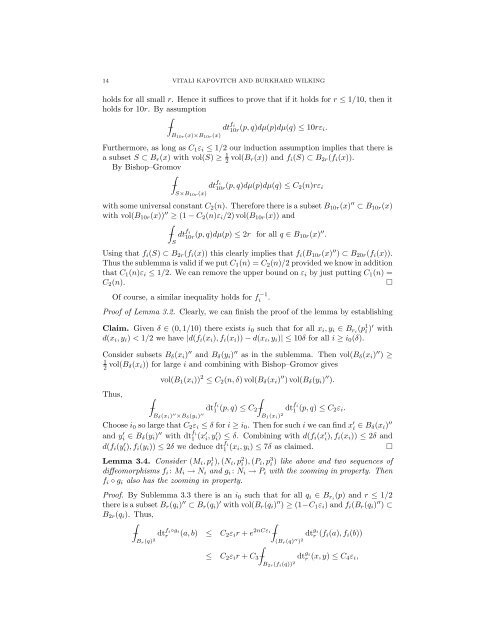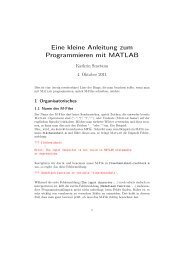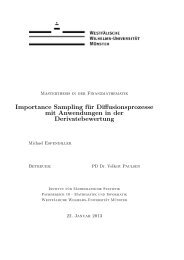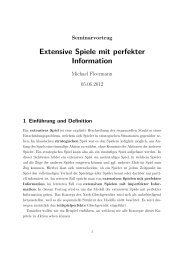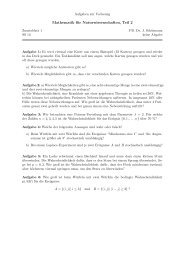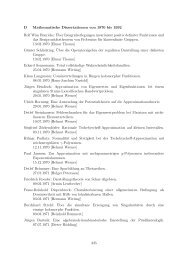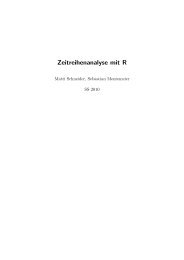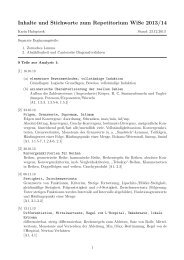Margulis Lemma
Margulis Lemma
Margulis Lemma
Create successful ePaper yourself
Turn your PDF publications into a flip-book with our unique Google optimized e-Paper software.
14 VITALI KAPOVITCH AND BURKHARD WILKING<br />
holds for all small r. Hence it suffices to prove that if it holds for r ≤ 1/10, then it<br />
holds for 10r. By assumption<br />
∫<br />
−<br />
dt fi<br />
10r (p, q)dµ(p)dµ(q) ≤ 10rε i.<br />
B 10r(x)×B 10r(x)<br />
Furthermore, as long as C 1 ε i ≤ 1/2 our induction assumption implies that there is<br />
a subset S ⊂ B r (x) with vol(S) ≥ 1 2 vol(B r(x)) and f i (S) ⊂ B 2r (f i (x)).<br />
By Bishop–Gromov<br />
∫<br />
− dt fi<br />
10r (p, q)dµ(p)dµ(q) ≤ C 2(n)rε i<br />
S×B 10r(x)<br />
with some universal constant C 2 (n). Therefore there is a subset B 10r (x) ′′ ⊂ B 10r (x)<br />
with vol(B 10r (x)) ′′ ≥ (1 − C 2 (n)ε i /2) vol(B 10r (x)) and<br />
∫<br />
− dt fi<br />
10r (p, q)dµ(p) ≤ 2r for all q ∈ B 10r(x) ′′ .<br />
S<br />
Using that f i (S) ⊂ B 2r (f i (x)) this clearly implies that f i (B 10r (x) ′′ ) ⊂ B 20r (f i (x)).<br />
Thus the sublemma is valid if we put C 1 (n) = C 2 (n)/2 provided we know in addition<br />
that C 1 (n)ε i ≤ 1/2. We can remove the upper bound on ε i by just putting C 1 (n) =<br />
C 2 (n).<br />
□<br />
Of course, a similar inequality holds for f −1<br />
i .<br />
Proof of <strong>Lemma</strong> 3.2. Clearly, we can finish the proof of the lemma by establishing<br />
Claim. Given δ ∈ (0, 1/10) there exists i 0 such that for all x i , y i ∈ B ri (p 1 i )′ with<br />
d(x i , y i ) < 1/2 we have |d(f i (x i ), f i (x i )) − d(x i , y i )| ≤ 10δ for all i ≥ i 0 (δ).<br />
Consider subsets B δ (x i ) ′′ and B δ (y i ) ′′ as in the sublemma. Then vol(B δ (x i ) ′′ ) ≥<br />
1<br />
2 vol(B δ(x i )) for large i and combining with Bishop–Gromov gives<br />
vol(B 1 (x i )) 2 ≤ C 2 (n, δ) vol(B δ (x i ) ′′ ) vol(B δ (y i ) ′′ ).<br />
Thus, ∫<br />
∫<br />
−<br />
dt fi<br />
1 (p, q) ≤ C 2− dt fi<br />
1 (p, q) ≤ C 2ε i .<br />
B δ (x i) ′′ ×B δ (y i) ′′ B 1(x i) 2<br />
Choose i 0 so large that C 2 ε i ≤ δ for i ≥ i 0 . Then for such i we can find x ′ i ∈ B δ(x i ) ′′<br />
and y i ′ ∈ B δ(y i ) ′′ with dt fi<br />
1 (x′ i , y′ i ) ≤ δ. Combining with d(f i(x ′ i ), f i(x i )) ≤ 2δ and<br />
d(f i (y i ′), f i(y i )) ≤ 2δ we deduce dt fi<br />
1 (x i, y i ) ≤ 7δ as claimed. □<br />
<strong>Lemma</strong> 3.4. Consider (M i , p 1 i ), (N i, p 2 i ), (P i, p 3 i ) like above and two sequences of<br />
diffeomorphisms f i : M i → N i and g i : N i → P i with the zooming in property. Then<br />
f i ◦ g i also has the zooming in property.<br />
Proof. By Sublemma 3.3 there is an i 0 such that for all q i ∈ B ri (p) and r ≤ 1/2<br />
there is a subset B r (q i ) ′′ ⊂ B r (q i ) ′ with vol(B r (q i ) ′′ ) ≥ (1−C 1 ε i ) and f i (B r (q i ) ′′ ) ⊂<br />
B 2r (q i ). Thus,<br />
∫<br />
∫<br />
− dt fi◦gi<br />
r (a, b) ≤ C 2 ε i r + e 2nCεi − dt gi<br />
r (f i (a), f i (b))<br />
B r(q) 2 (B r(q) ′′ )<br />
∫<br />
2<br />
≤ C 2 ε i r + C 3 −<br />
r (x, y) ≤ C 4 ε i ,<br />
B 2r(f i(q)) 2 dt gi


